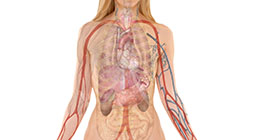
Overview
Symptoms
Causes
Prescription
Health Tips
Dysmenorrhea, or painful menstruation, is one of the most common menstrual complaints. When menstrual cramps occur each month, and are not due to any underlying condition this is known as primary dysmenorrhea. Around 60 percent of Canadian women who menstruate will experience primary dysmenorrhea at some point in their child-bearing years. Of those women, 5 to 15 percent will experience pain severe enough to interfere with normal activities. Secondary dysmenorrhea is when cramps are due to reproductive health conditions, such as uterine fibroids, cysts or endometriosis.
Symptoms
Symptom severity may vary from month to month and woman to woman, but the following are common:
- Headaches
- Nausea
- Pain radiating through hips, lower back, and thighs
- Painful abdominal cramps which may be sharp or dull, starting shortly before menstruation and lasting 2 to 3 days
- Vomiting
Causes
Primary dysmenorrhea pain is thought to be due to the increase of prostaglandins released during menstruation. Prostaglandins are fatty hormone-like substances in the body that play a role in inflammation, blood flow/clots, and contractions during labour. In addition, they cause the uterus to contract during menstruation. Contractions help to dislodge and expel the uterine lining. When contractions occur, blood supply to the lining of the uterus diminishes. Women with higher prostaglandin levels experience more pain. The expulsion of clots through the cervix is also a source of pain.
A diet high in white refined carbohydrates, sugar, and dairy may cause a rise in inflammation and contribute to cramping. Because of this, it is important to consume a diet that helps to reduce inflammation.
Other factors that can contribute to painful periods are:
- Being overweight
- Family history of heavy periods
- Heavy periods
- Sedentary life
- Smoking
- Starting menstruation before the age of 12
- Stress
Secondary dysmenorrhea can be the result of such conditions as endometriosis, pelvic inflammatory disease, an STI, adenomyosis (abnormal cell growth), fibroids, cysts, and abdominal adhesions. Intrauterine devices (IUD) can also cause or increase menstrual cramps in some women.
Prescription For Health
It is important to rule out any health conditions that may be causing secondary dysmenorrhea.
| Nutrient | Dosage | Action |
|---|---|---|
| Nutrient | Dosage | Action |
| Calcium D-glucarate* | 150 mg
|
Important for healthy metabolism of estrogen; supports normal cell growth; combined with I3C and sulforaphane, stops abnormal periods and period pain |
| Turmeric (95% curcumin)* | 50 mg | Prevents abnormal cell growth, detoxifies cancer-causing forms of estrogen |
| Indole-3-carbinol* | 150 mg | Eliminates excess toxic and cancer-causing estrogens
Has been shown to reverse abnormal PAP tests within three menstrual cycles Halts flooding periods and normalizes menstrual cycle |
| Rosemary extract* | 25 mg | Reduces tumor formation, is antioxidant |
| Di-indolylmethane (DIM)* | 50 mg | Antioxidant, reduces risk of cancer |
| Sulforaphane* | 200 mcg | Reduces risk of cancer
Stops abnormal cell growth Halts flooding periods and abnormal menstrual cycle |
| Chaste tree berry (Vitex)* | 80 mg | Enhances LH which increases progesterone to promote healthy ovulation |
| Zinc* | 6 mg | Zinc helps to increase progesterone and decrease estrogen
PMS sufferers are more likely to have low zinc |
| Natural Progesterone Cream (Prometrium) | In Canada, progesterone cream is a prescription drug
Mid cycle (day 15) take 200 mg at bedtime until day 28 |
Restores progesterone level and used to promote menstruation |
| Borage Oil | 2000 mg daily | Anti-inflammatory; controls inflammatory prostaglandins involved in pain and inflammation |
Health Tips to Enhance Healing
- Acupuncture can minimize pain due to cramping.
- Aim for 30 minutes of exercise a day. Activities such as swimming, walking, or cycling help relieve stress and relax the body. They may also increase blood flow which can reduce cramps.
- Drink raspberry leaf tea which may reduce cramping.
- Have a warm bath.
- Include organic lean proteins, vegetables, whole grain, fruit and high-quality fats and EFAs.
- Minimize or remove dairy from diet; small amounts of organic butter and yogurt are okay.
- Processed foods, refined grains, and sugar should be removed or limited as they can increase inflammation in the body.
- Reduce or avoid caffeine and alcohol.
- Reduce stress levels, see Adrenal Fatigue for tips.
- Stop smoking.
- Use a heating pad or hot water bottle to ease pain.










